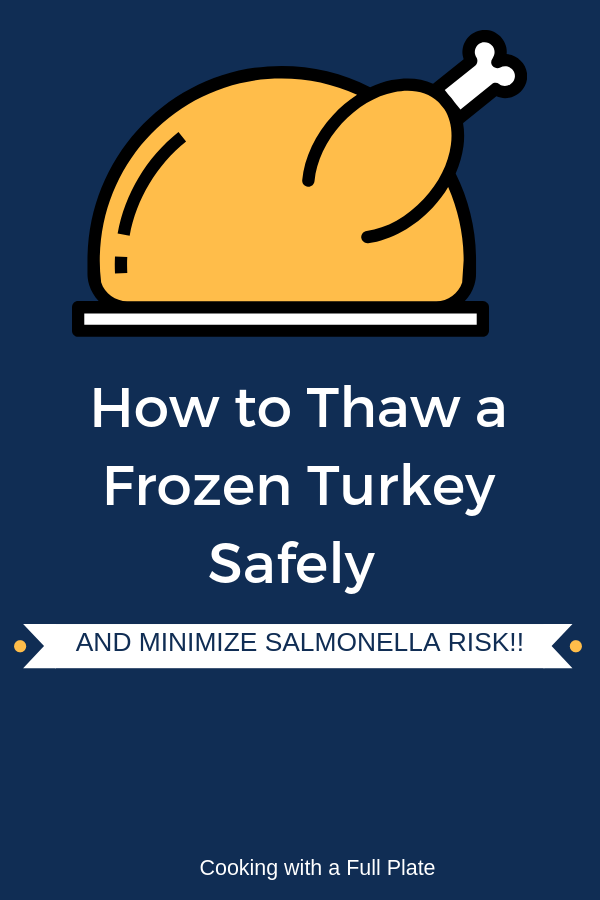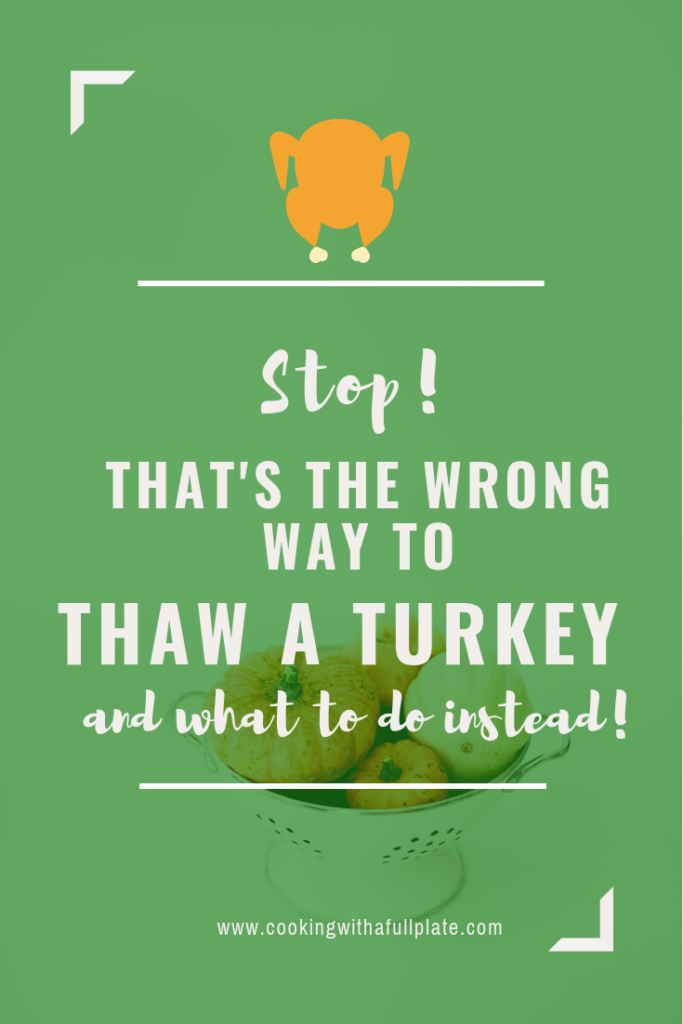Alternate titles for this article included: Don’t Serve Your Thanksgiving Turkey with a Side of Salmonella and What your Mom Taught you about How to Thaw a Turkey Safely is all Wrong. (Or maybe it was just my mom.) But seriously, let’s talk today about how to thaw a frozen turkey safely.
Have you heard about the recent turkey salmonella outbreak that was announced just in time for Thanksgiving 2018? Awesome. Just what we needed. Another thing to worry about.
What does this have to do with cooking for a family? Oh, just everything. First of all, kids and elderly folks are more susceptible to salmonella contamination. Plus, I know you’re really freaking busy during the holiday season and you might not have the time or energy to think about food safety on top of the rest of what you’re doing. This guide is an attempt to make things easier.
Spoiler alert: If you want to just know exactly what to do this is it – don’t spread raw turkey juices around your kitchen or fridge, defrost your frozen turkey in the refrigerator by planning far enough ahead to make it happen, and cook your turkey to the correct temperature all the way through.
Throughout the rest of this article, I’ll explain all of that in more detail. So let’s talk about what we know and how to avoid serving your Thanksgiving turkey with a side of salmonella.
Raw Turkey Salmonella Outbreak
According to the CDC, “CDC and public health and regulatory officials in several states are investigating a multistate outbreak of multidrug-resistant Salmonella infections linked to raw turkey products. The U.S. Department of Agriculture’s Food Safety and Inspection Service (USDA-FSIS) is monitoring the outbreak.” As of November 8, 2018, 164 individuals, across 35 states have contracted salmonella from raw turkey products; 64 people have been hospitalized and 1 person in California has died.
But, don’t panic yet that your Thanksgiving is ruined! The CDC is not, at this point, advising that consumers stop consuming turkey products or that retailers stop selling them. Rather, they are recommending that we, “Always handle raw turkey carefully and cook it thoroughly to prevent food poisoning.”
So, let’s talk about how to handle a raw turkey and cook it to prevent food poisoning:
At Which Points Am I Most Likely to Spread Salmonella?
Good question! There are some key times between bringing home the turkey from the store and serving it on your Thanksgiving table that you are most likely to spread salmonella. Some extra attention at these points will help to ensure that you aren’t spreading uncooked turkey germs that may contain salmonella:
Bringing the Turkey Home from the Store
While your turkey is usually frozen at this point, it can start defrosting and spreading raw turkey juice during transport as well. In order to minimize transfer of said juices to your car, kitchen floor, and everywhere in between, definitely take advantage of the large plastic shopping bags that they have available in most meat aisles. Better yet, take two and layer them around your turkey.
Storing Turkey in the Refrigerator
You’re ready to put your turkey aside in the fridge until it’s time to cook it. (This is, BTW, the best place to defrost it. More on that later.) Two things you’ll want to remember here:
- Raw meats should always be stored on the bottom shelf of your refrigerator: This will minimize the cross-contamination risk if any raw juices do make their escape
- Place the turkey in a large container in the refrigerator: In addition to being on the bottom shelf, you should also place your turkey in a large container that can catch and contain the raw juices as it defrosts. Having cleaned up melting turkey juice from the bottom of the fridge in the past, I assure you that giving up one of your containers for a bit is preferable to this daunting task, especially if a risk of salmonella is involved
Defrosting the Turkey
As I mentioned above and will talk about more below, defrosting is best done in the refrigerator and we’ve covered some of the basics on minimizing salmonella contamination risks there. That said, if you follow one of the other defrosting methods, you’ll want to make sure that you thoroughly clean any surfaces involved in that step as well.
Preparing the Turkey for Cooking
For starters, it’s worth noting that it’s no longer recommended that you wash raw poultry before preparing it. It turns out that washing it actually makes it more likely that you’ll spread contamination than it is likely that you’ll “clean” the food.
Next, you’ll want to remember to wash your hands thoroughly and regularly. When I was working in commercial kitchens we used to joke that whenever you thought of washing your hands that probably meant you should have done it twice already. Moral of the story? It’s really hard to wash them too much and your food, your kitchen, and your health will be better for it.
Also, be sure to thoroughly wash and sanitize any surfaces that come in contact with the raw turkey right away. This means you should sanitize cutting boards, knives, and countertops that you are using on the turkey. On holidays like Thanksgiving where the kitchen can get really busy, I like to do all of that immediately to ensure that no well-meaning helper comes along and inadvertently spreads the germs by not know what’s dirty or clean. In addition, don’t forget that if you touch a kitchen towel with raw turkey it should be taken out of rotation immediately.
There are some ideas on how to effectively sanitize kitchen utensils and cutting boards here.
How to Thaw a Frozen Turkey Safely
Now that you know which points in turkey preparation you most need to pay attention to the spread of salmonella, let’s talk a bit about how to thaw a frozen turkey safely.
But first, a story. Growing up, we never seemed to manage to get our turkeys fully defrosted before it was time to cook it. At this point, I hadn’t taught culinary classes or worked in a professional kitchen, but even then, I was dubious with some of the approaches used to get the turkey fully thawed. Some that stand out in my mind are:
- Leaving the raw turkey on the counter “for a bit” until it was fully defrosted
- Placing the turkey in a sink filled with water for a few hours
- In the microwave (when it would fit)
I’m sure I’m not alone in having seen, or maybe even having used, one of these techniques in the past. But the truth is, there are only 3 ways to thaw a frozen turkey that are safe:
- In the refrigerator
- Submerged in cold water, with the water being changed every 30 minutes
- In the microwave (my thoughts on this later)
So why can’t you just leave the turkey on the counter? It’s all about the “temperature danger zone“.
The temperature danger zone is the temperature range where bacteria is most likely to grow. Stay under the temperature danger zone and it’s too cold for the bacteria to grow. Stay above it and it’s too hot.
Room temperature is basically the worst temperature to hold food at. If your house is a comfortable 68° F that would put it squarely in the temperature danger zone. So if your raw turkey is sitting on the counter for hours defrosting, it is also becoming a hotbed of bacteria growth. Add in the additional risk of salmonella contamination this year and you’re asking for trouble.
So don’t risk it! Here’s what you should do instead:
How to Thaw a Frozen Turkey in the Refrigerator
This is by far the best, easiest, and most hands-off method for defrosting your turkey. The major thing you’ll need to do is plan ahead.
- Place the turkey in its packaging, in a container (platter, roasting pan), on the bottom shelf of the refrigerator (make sure it’s set to less than 40° F)
- Do this 1-6 days before you plan to cook the turkey depending on the size (there’s a cool chart here that can help)
- When you’re ready to cook, remove the turkey from refrigerator, remove the packaging, and cook according to your recipe
How to Thaw a Frozen Turkey in Water
If you’ve gotten to turkey day and your turkey STILL isn’t defrosted, water can help make it defrost faster. Here’s how:
- Place the turkey in a leak-proof plastic bag to prevent contamination and/or water-logging the product
- Clean your kitchen sink and plug it. Fill with cold water and submerge the turkey
- Change the water every 30 minutes. Let me repeat that CHANGE WATER EVERY 30 MINUTES. I know you’ll be tempted not to, but if you don’t have clean water that is under 40°F then you’re basically taking the turkey’s bacteria, spreading it around, and then making it grow
- Allow about 30 minutes per pound for the turkey to defrost
- Cook the turkey immediately and thoroughly clean the sink once you’re done using it
The truth is, this is a fairly labor-intensive process, or as The Spruce aptly points out “…a very large turkey, like a 20-pounder, which can take ten hours or more to defrost, you would have to change the water every thirty minutes for ten hours. That’s twenty water changes!”
How to Thaw a Frozen Turkey in the Microwave
You’ll notice that I included the microwave as a not ideal technique that I witnessed growing up and also a safe method. The truth is that it’s both.
While you can safely defrost a turkey in the microwave thanks to the fast nature of it and the resulting limited time in the temperature danger zone, it doesn’t make for a great turkey. I find it almost impossible to:
- Fit it in the microwave
- Defrost it without also cooking some of the meat through, which results in a really tough turkey
That said, if you insist or you’re REALLY in a pinch, here’s how to do it according to the USDA:
Follow the microwave oven manufacturer’s instruction when defrosting a turkey. Plan to cook it immediately after thawing because some areas of the food may become warm and begin to cook during microwaving. Holding partially cooked food is not recommended because any bacteria present wouldn’t have been destroyed.
Now that you’ve safely defrosted your turkey, the last step to serving a delicious, salmonella-free turkey is to cook it!
How to Cook Your Thawed Turkey Safely
The truth is, I’m not a turkey cooking expert. In fact, it’s the one thing that I often ask someone else to do even when I’m hosting.
So instead of trying to pretend I’m an expert, I’m going to refer you to some awesome folks who are:
- How to Safely Cook a Whole Turkey
- Tips on Stuffing Turkey and Measuring the Temperature
- How to Roast a Turkey
Bon Appetit! Here’s to a meal filled with delicious favorites, fantastic conversation, and no salmonella.
This post contains affiliate links. As an Amazon Associate I earn from qualifying purchases.

